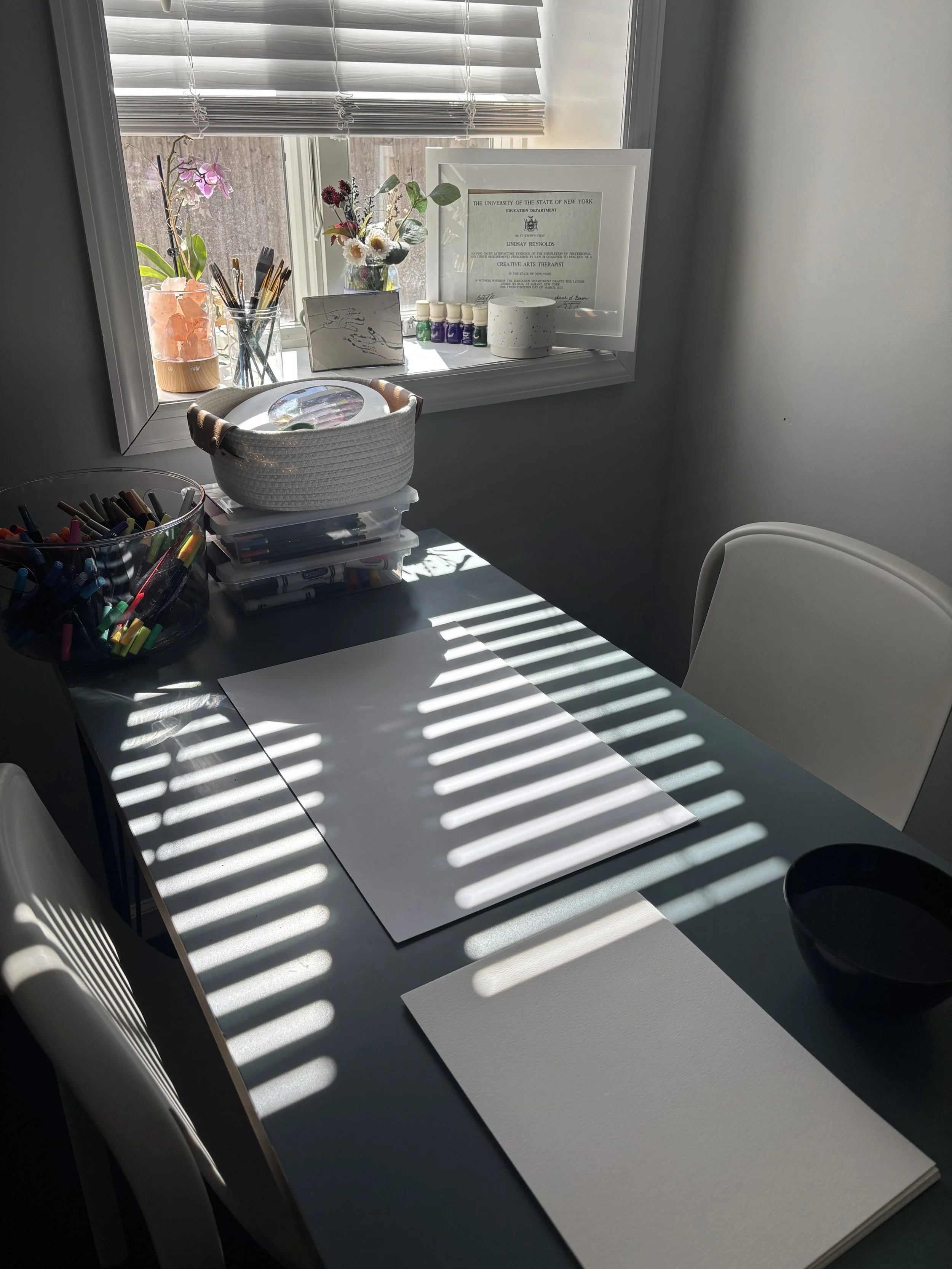Noticing
The Art of Noticing: How Creative Arts Therapy and EMDR Help Calm Fall Stress
Fall always comes with a rush. New teachers, new classrooms, new routines, new demands. On the outside, it looks like excitement — backpacks filled, calendars stacked, sports in full swing. But underneath? The thoughts begin to hum.
For kids, it might sound like:
“OMG my parents are going to kill me — another zero.”
“I’ll just eat in the library.”
“I can’t believe they said that about me.”
“Please don’t ask me to read.”
“You don’t get it.”
For adults, the soundtrack changes but the weight is the same:
How the f** am I supposed to keep up with all these overlapping schedules without dropping the ball somewhere?
Of course my jeans don’t fit.
When is the last time I actually had a conversation that wasn’t a work call or about the kids’ practices?
When the hell do I get a day to myself?
How is it only October and I already feel completely wiped out?
By the time the leaves turn, the body already feels it: the pressure, the rushing, the exhaustion of keeping it together. The nervous system doesn’t miss a thing. It tightens, braces, scans. Sometimes it buzzes with anxious energy. Sometimes it drops into numbness just to survive.
These aren’t personal failures. They’re survival responses. But living only in survival costs something important: presence, connection, safety.
That’s where noticing matters.
Why Your Body Reacts This Way
When life gets heavy, the body reacts before the mind has time to catch up. Sometimes it revs — heart pounding, thoughts racing, muscles tight. Other times it shuts down — low energy, flat, disconnected.
For kids, that might look like hiding in the library, pretending grades don’t matter, or trying to laugh off a cruel post. For adults, it might look like zoning out in front of the TV, snapping at loved ones, or staying up late to scroll because the quiet feels unbearable.
The body is always trying to protect. But when protection becomes the default, it’s easy to forget what calm even feels like.
Lindsay Reynolds. START Creative Arts Therapy. West Islip, NY
Noticing as a Reset
Noticing doesn’t mean fixing everything. It means catching what’s happening right now.
And yes, it’s natural to roll your eyes: Notice? Really? Who has time for that? Add it to the list — pack the lunches, send the emails, sit in traffic, fold the laundry, pour the wine, take the melatonin — and now I’m supposed to “notice.”
But noticing isn’t another chore. It’s the pause that interrupts the cycle and reminds your body it doesn’t always have to run on survival mode.
It might be realizing your jaw is locked after a long day.
It might be noticing the ache in your chest when your kid tells you about a hard day.
It might be catching the way your shoulders finally drop when someone makes space for you.
Even the smallest details — the crunch of leaves, the smell of coffee, the light across the kitchen floor, the rhythm of your breath — tell the body: you’re here, and you’re safe enough to pause.
via Unsplash
Creative Arts Therapy: A Safe Place to Notice
Sometimes noticing feels impossible if it only happens in your head. That’s where creative arts therapy comes in — creating safe ways to notice that don’t feel forced.
And still, the thought comes: Great. But when?
Here’s the truth: you’re already giving that time away — to distractions that numb, to exhaustion that flattens, to commitments that leave no space for you. Therapy isn’t about adding more. It’s about trading what drains you for what restores you.
And kids need this too. Their days are just as packed — classes, sports, activities, social drama — and many of them are already coping in ways that hide how stressed they really feel. Replacing one more pressured commitment with therapy gives them a space that’s restorative, creative, and safe.
Creative arts therapy offers that space.
Art gives shape to feelings when words fall short.
Movement shows where the body is bracing — and what it feels like to let go.
Music steadies breath and heartbeat with rhythm, helping energy regulate.
Drama lets you try on the masks and roles you carry — and then set them down.
It’s not about creating something perfect. It’s about showing up for yourself — and giving your kids the same chance.
START: Creative Arts Therapy Services creates this kind of space every day for kids, teens, and adults. If you’re curious about how therapy could fit into your already packed life, learn more or schedule a session at www.startcreativearts.com.
via Unsplash
EMDR: Another Path to Noticing
And if you think the arts aren’t for you — EMDR offers another way in. Noticing is also at the heart of EMDR (Eye Movement Desensitization and Reprocessing). In sessions, clients observe sensations, images, and thoughts while staying grounded in the present.
Before diving into difficult memories, EMDR builds resources — calming images, safe places, supportive memories. These anchors remind the body what safety feels like. With resources in place, noticing doesn’t overwhelm. It steadies.
For adults, EMDR creates a different path than powering through or shutting down. For kids, it offers a safe way to process what feels too big to hold alone.
Over time, the body learns: I can be with this. I can notice this. I can stay.
via Unsplash
What Fall Teaches About Healing
October models this work. Trees don’t drop all their leaves in a single day. They let go slowly, one at a time.
Healing works the same way. It doesn’t come in one big moment. It begins with noticing.
Noticing when your breath shortens.
Noticing when your body braces.
Noticing when something — a sound, a color, a smell — brings you back.
Every act of noticing teaches the nervous system: it’s safe enough to be here.
Here’s the thing: life isn’t slowing down. The schedules, the deadlines, the pressure — they’ll always be there. What changes is whether you keep surviving it, or start reclaiming pieces of yourself in the middle of it.
Therapy isn’t just “something nice” if you have time. It’s the replacement for the patterns that leave you exhausted and disconnected. It’s the space where your nervous system learns safety again. It’s the pause that helps you show up not only for yourself but for the people you love.
This October, give yourself permission to notice. Notice one thing in your body, in your breath, in your day. And if you’re ready, let therapy be the place where those small acts of noticing grow into real change.
Take that next step with us. Because the first step out of survival isn’t doing more. It’s remembering that you and your kids deserve the space to notice what’s already here.
via Unsplash







